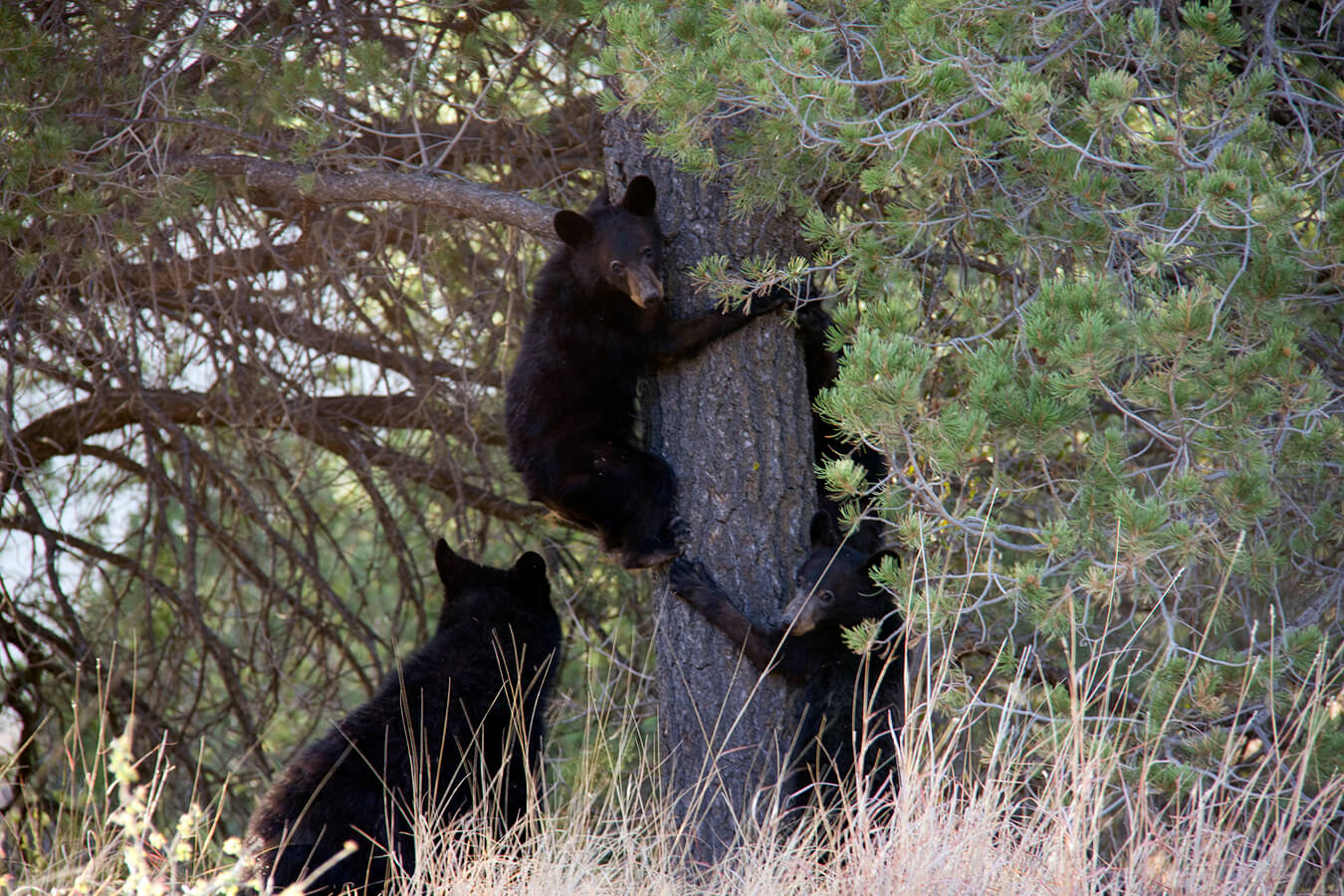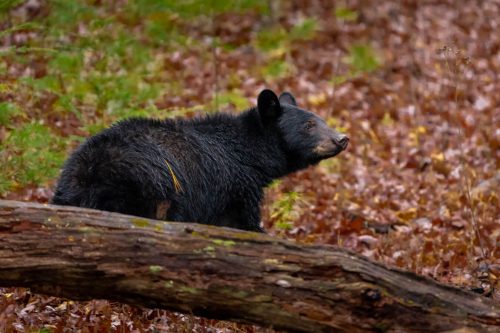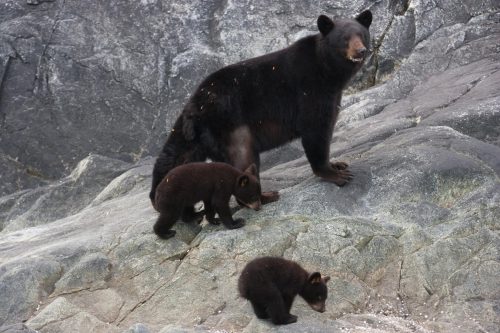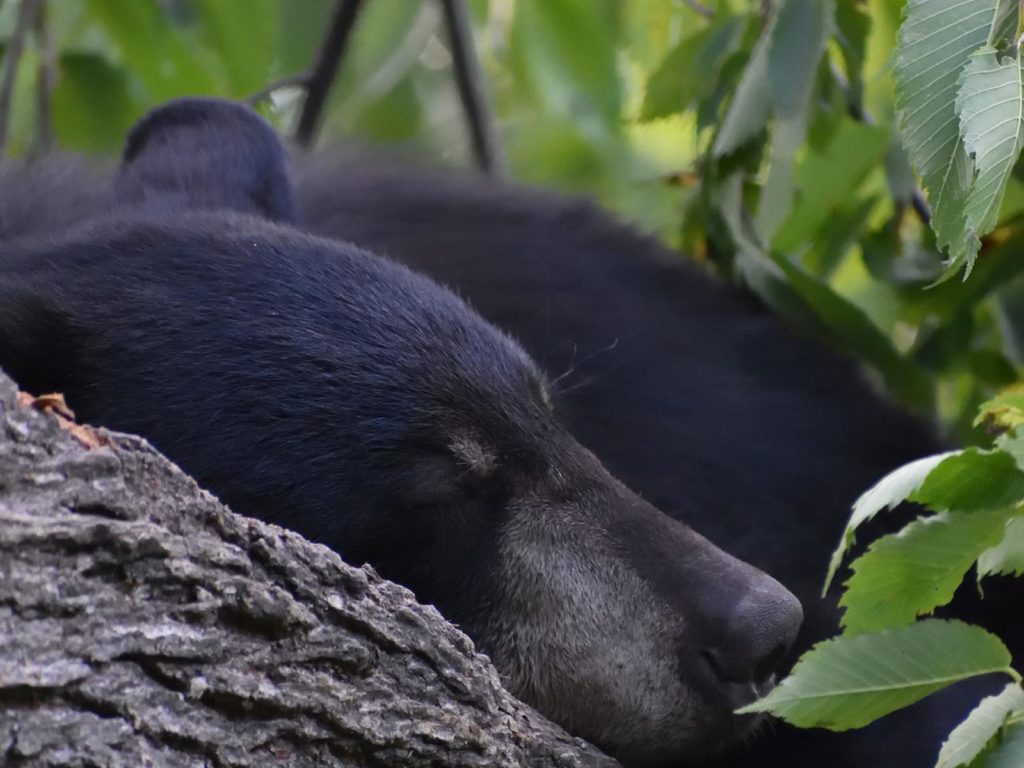
The American Black Bear (Ursus americanus) is a fascinating and adaptable mammal, known for its versatility and wide distribution across North America. As the most common bear species on the continent, it inhabits a diverse range of environments from the dense forests of the eastern United States to the rugged mountains and coastal regions of the west. Due to their awe inspiring presence, American Black Bears can be very rewarding photography subjects, but are not for the faint of heart. Special care should be taken when photographing these animals and safely should always remain the top priority.
Learning about animals, like the American Black Bear, can significantly enhance wildlife photography skills by providing crucial insights into animal behavior, habitat and physical attributes. Understanding an animal’s habits can allow photographers to safely anticipate and capture unique and authentic moments. While knowledge of an animal’s habitat may help in selecting the best locations and times for shooting. Familiarity with physical attributes of specific species is also crucial in identifying and adding value and accuracy to the photographs.
If wildlife photography or simply wildlife viewing are of interest to you, then you’ve come to the right place! Together let’s learn more about what makes the American Black Bear such a special species and symbol of the North American wilderness.
Biology and Physical Characteristics

The American Black Bear is medium-sized compared to other bear species, with adults typically weighing between 100 to 600 pounds and standing about 5 to 6 feet tall when on their hind legs. Their fur color can vary significantly, ranging from black, brown, cinnamon, blond and blue-gray, or white in rare instances, such as the Kermode or “spirit” bear found in British Columbia.

American Black Bears possess strong, curved claws that are adept for climbing trees, a skill they often utilize to escape danger or forage for food. Their keen sense of smell, one of the most acute in the animal kingdom, helps them locate food over great distances. Despite their name, not all American Black Bears are black. Fur color can vary even within the same litter, influenced by genetics and environmental factors.

Habitat and Distribution

American Black Bears are highly adaptable and can be found in a variety of habitats including forests, swamps, and mountainous regions. They thrive in areas with dense vegetation that provide cover and ample food sources. Their range extends from Alaska and Canada through much of the contiguous United States and into northern Mexico.
These bears are solitary creatures, except for mothers with cubs or during the mating season. They establish home ranges that vary in size depending on the availability of food and habitat quality. Male black bears typically have larger territories than females, which they mark with scents and tree scratches to communicate with other bears.
Diet and Foraging Behavior

American Black Bears are omnivores with a diet that changes seasonally. In spring, they feed on young plants, insects, and carrion left over from winter. Summer offers a bounty of berries, fruits, and nuts, which are staples of their diet. In the fall, they gorge on acorns, beechnuts, and other high-fat foods to build up reserves for winter hibernation.
Black bears are opportunistic feeders and will also consume human food and garbage if accessible, leading to potential conflicts with humans. Their ability to exploit diverse food sources is a key factor in their success across varied environments.
Behavior and Reproduction

American Black Bears are generally shy and avoid humans, but they can become bold if they associate people with food. This can lead to dangerous encounters and underscores the importance of proper food storage and waste management in bear country.
The breeding season for black bears occurs from June to July. After mating, females undergo delayed implantation, where the fertilized egg remains dormant until the fall. If the female has accumulated sufficient fat reserves, the embryo will implant and begin to develop. Cubs, usually born in January or February, are blind and helpless at birth, relying entirely on their mother’s milk and protection. A typical litter consists of one to three cubs, which remain with their mother for about 18 months.
Hibernation
Black bears enter a state of hibernation in the winter, although it is not a true hibernation. During this period, their metabolism slows, and they live off their fat reserves. They do not eat, drink, urinate, or defecate while denning. Hibernation is a critical survival strategy that allows bears to endure periods when food is scarce.
Dens can be located in hollow trees, caves, or even beneath the roots of large trees. The choice of a den site is crucial for the bear’s survival and the protection of its cubs during the vulnerable early months of their lives.

Conservation and Human Interaction

Historically, black bear populations suffered due to habitat loss and hunting. However, conservation efforts and improved management practices have led to a rebound in many areas. Black bears are currently listed as “Least Concern” by the International Union for Conservation of Nature (IUCN), but local populations may face threats from urban expansion and climate change.
Human-bear conflicts remain a significant challenge. As urban areas encroach on bear habitats, bears are more likely to encounter humans and access anthropogenic food sources. Education and proactive measures, such as bear-proof garbage containers and public awareness campaigns, are vital in mitigating these conflicts.
Wildlife management strategies often include monitoring bear populations, regulating hunting seasons, and protecting critical habitats. These efforts help ensure the sustainable coexistence of bears and humans.
The Cultural Significance of the American Black Bear

The American Black Bear holds a prominent place in the cultural history of North America. Indigenous peoples have long revered the black bear, viewing it as a symbol of strength, courage, and resourcefulness. Bears appear in numerous myths, stories, and spiritual practices across different cultures.
In modern times, the black bear continues to captivate the public’s imagination. It is a popular subject in art, literature, and media, representing the untamed beauty of the wilderness. For many, the black bear embodies the spirit of the North American wilderness, symbolizing the need to preserve natural habitats and wildlife.
National Park Presence & Wildlife Photography
The American Black Bear is thought to be present in 43 National Parks in varying degrees of abundance. If you visit one of the parks in hopes of seeing and photographing an American Black Bear, keep a sharp eye and be patient. Wildlife is wild and unlike landscape photography, viewing specific types of wildlife can be hit or miss.
If wildlife does present itself, always make sure to maintain a safe distance. Using a telephoto lens allows for close-up shots without intruding on the animals’ space. If you already own or want to own a professional grade mirrored camera like the Canon EOS 5D Mark IV Full Frame Digital SLR, we recommend using a Canon EF 100-400mm f/4.5-5.6L is II USM Lens zoom lens for wildlife photography. If you have or are interested in a newer mirrorless model like the Canon EOS R5 Full-Frame Mirrorless Camera, we recommend using a Canon RF100-400mm F5.6-8 is USM Black for long distance shots.
Not quite ready to invest in traditional professional grade camera equipment, but want to enhance the quality of your cell phone photographs? Consider using a Moment 58mm Tele Lens for an improved zoom and be sure you have a compatible phone case to mount your new lens in. Since cell phones don’t have the same zoom distance and quality as traditional professional cameras, be extra mindful about your distance from wildlife when photographing them and don’t get too close.
Below is a list of National Parks where the American Black Bear may be spotted:
Final Thoughts
Wildlife viewing and photography offer numerous benefits, both for individuals and for broader conservation efforts. Engaging in these activities fosters a deep connection with nature, promoting mental well-being and reducing stress through the tranquil experience of observing animals in their natural habitats. It also enhances physical health through outdoor exploration and boosts creativity and patience. On a broader scale, wildlife photography raises awareness about the beauty and diversity of animal species, inspiring conservation efforts and environmental stewardship.
The American Black Bear is a remarkable species, exemplifying adaptability and resilience. As an integral part of North America’s ecosystems, black bears play a crucial role in maintaining ecological balance. Their story is one of recovery and coexistence, demonstrating how conservation efforts can make a positive impact.
Understanding and respecting the American Black Bear is essential for ensuring its continued presence in the wild. By appreciating their role in nature and fostering harmonious relationships with these magnificent creatures, we can help protect one of North America’s most iconic animals for future generations to admire and cherish.

Want more information about the amazing wildlife that call our National Parks home? Take a look at our National Park Wildlife page to explore the various parks and the animals in them. Planning on visiting a National Park in the near future? Be sure to follow park regulations, practice “Leave No Trace” principles, and prioritize safety while exploring.
Joyful Journeys!
Bonnie, Co-Owner, National Park Photographer
Want to learn more about the American Black Bear? Check out the links below!
- American Black Bears (First Facts)
- Tracking the American Black Bear
- The American Black Bear: Life in the Wild
- North American Black Bears (Woodland Wildlife)
- All About North American Black Bears (Animals Around the World)
- Retro Bears Knowledge Metal Tin Sign
Want to see a black bear walking at Bartlett River in Glacier Bay National Park? Visit the links below:
American Black Bear (Ursus americanus) – Walking near Bartlett River in Glacier Bay National Park
American Black Bear (Ursus americanus) – Chewing near Bartlett River in Glacier Bay National Park
Please note, by making purchases through our affiliate links, you are supporting our mission to celebrate and showcase our National Parks and the photographers who frequent them. As an Amazon Associate, National Park Photographer earns from qualifying purchases at not cost to you. We appreciate your support.






